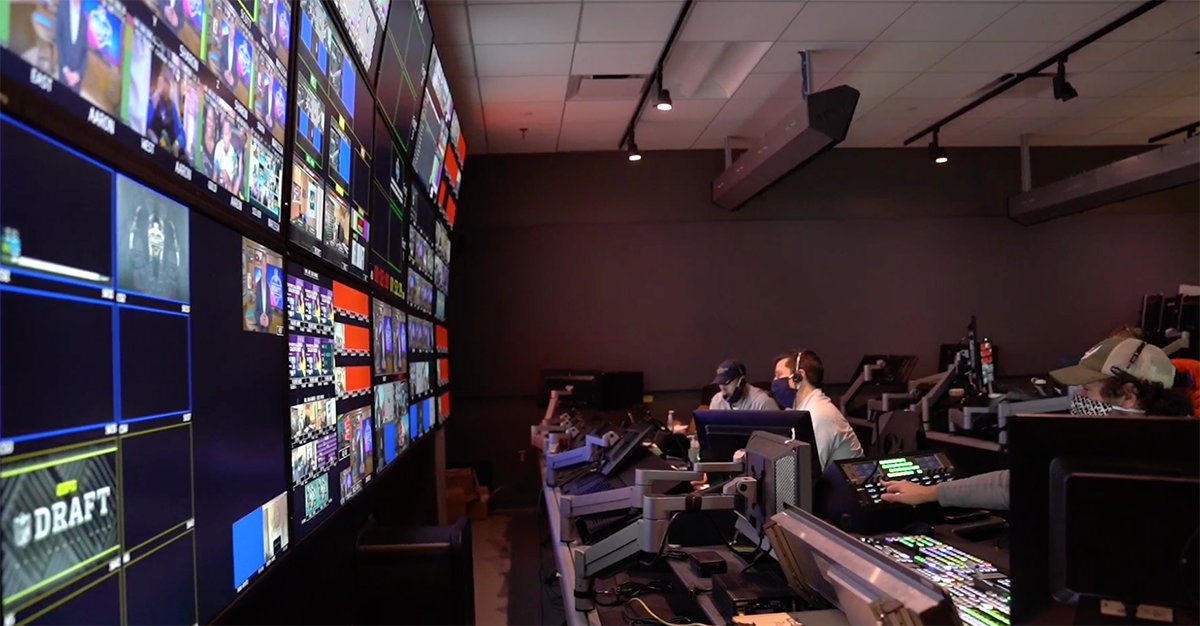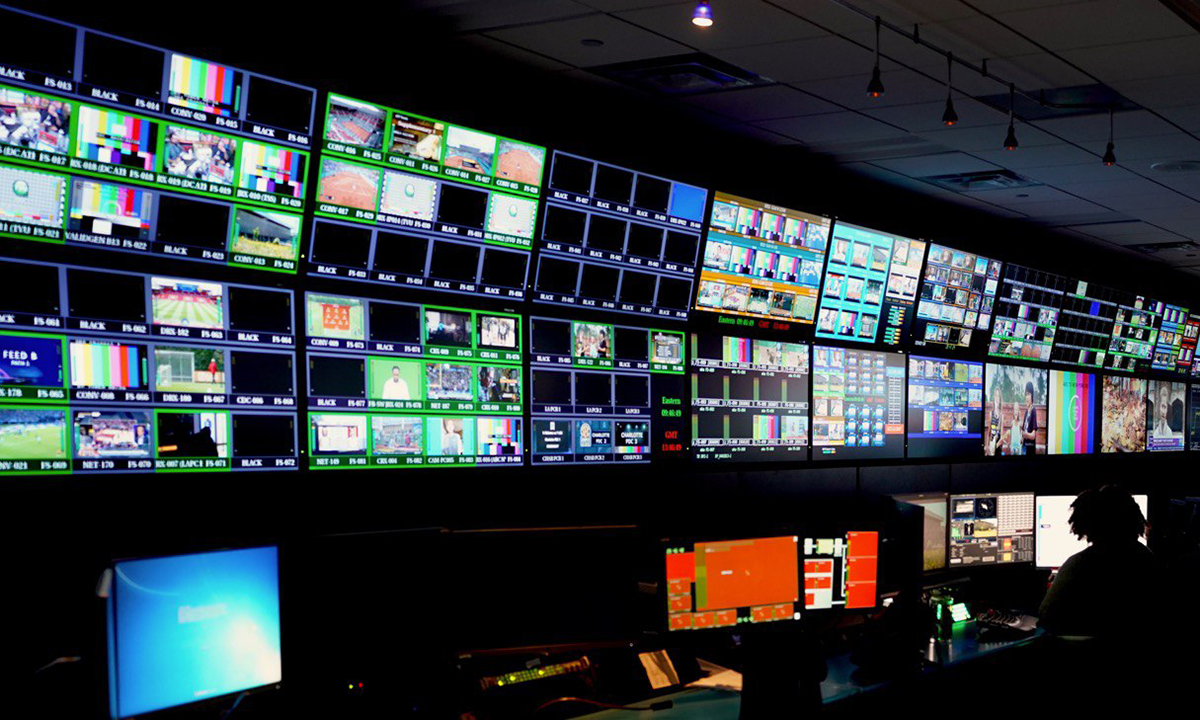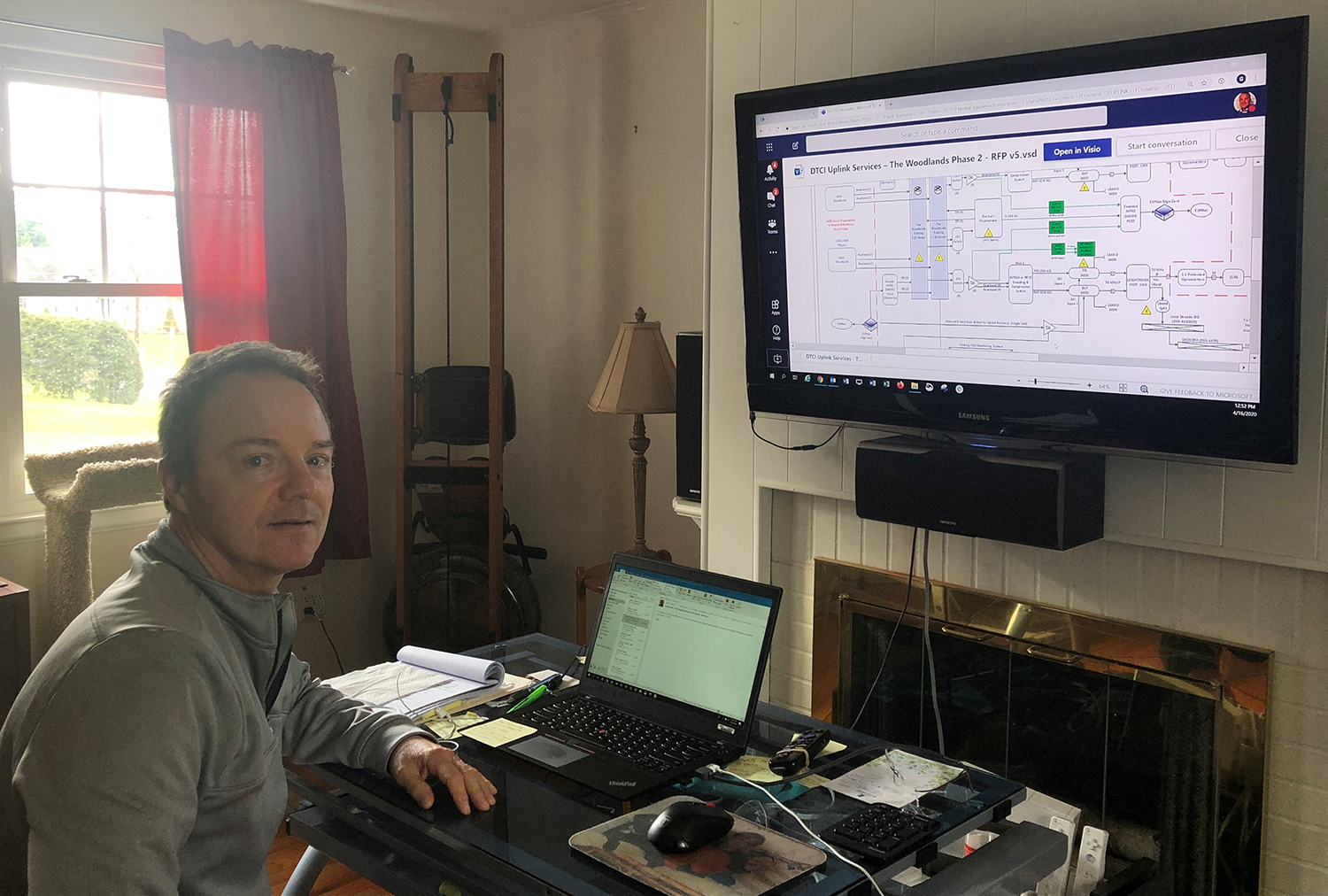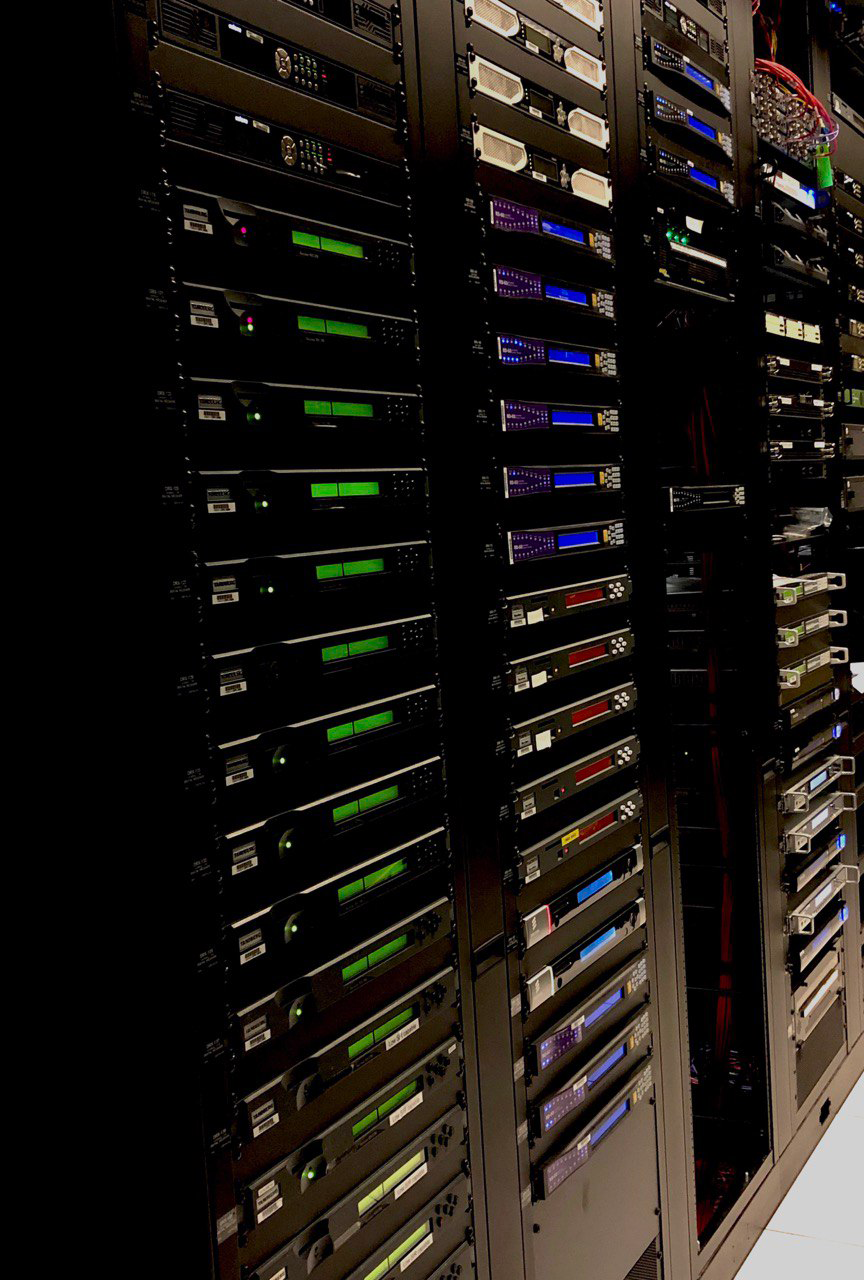NFL Draft 2020: ESPN Production, Disney DTCI Technology Teams Tackle Most Unique Draft Production Ever
With more than 150 feeds flying in to Bristol, the three-day live event poses a never-before-seen challenge
Story Highlights
The NFL Draft is a live production that has never been short on obstacles.
Whether it was pulling feeds out of a hotel ballroom in the ’80s to stringing aerial cameras over a sea of rowdy humanity on the Cumberland River Greenway in Downtown Nashville last year, the NFL Draft has always presented ESPN’s staff with brain-bending puzzles that it has thrived on solving.
This Draft, though, is something totally different.

While much of the behind-the-scenes crew (and even on-air talent) are working from home, ESPN’s Bristol, CT, campus is staffed for NFL Draft coverage. All crew members are operating under social-distancing guidelines with no more than seven in control rooms, and all are directed to wear facial coverings.
It was just a couple of weeks into the coronavirus-fueled sports shutdown when it became increasingly clear: the NFL Draft was, indeed, going to go on as planned beginning on April 23.
That’s when Mike Feinberg, coordinating director, studio directing and production, ESPN, went to his colleagues at Disney’s Direct-To-Consumer & International (DTCI) Technology segment with a whole new scheme for pulling off a live production unlike anything any of them had ever worked on.
“The first thing I thought was, ‘You’re out of your mind. There’s no way,’” laughs Vinny Thibeau, associate director, transmission, DTCI Technology. “But why can’t we do this? We have the equipment. We have the infrastructure that is not being tied up by a thousand other events on a Saturday. Let’s put it all out there.”
Live coverage of the 2020 NFL Draft — which begins tonight at 7 p.m. ET on ESPN, ABC, and the NFL Network — will be a nationwide effort from inside ESPN’s Bristol, CT, campus to the NFL Network to the homes of NFL Commissioner Roger Goodell and NFL GMs, coaches, and Draft prospects around the country. And it’s a challenge being taken head-on behind the scenes by both the Disney DTCI Technology transmission team and ESPN’s Content Operations and Studio Directing and Production teams.
Check out more of SVG’s coverage of the 2020 NFL Draft:
- NFL Media Deploys iPhone Production Kits, Coordinates 600+ Live Feeds to Bring Virtual Draft to Fans
- NFL Franchises Connect With Fans Through Live Streams, Interactive Posts on Social Media
- Bleacher Report Builds Remote, Distributed Control-Room Infrastructure To Deliver Live Coverage
Crowded Transmission Traffic Map
Working in partnership with the NFL, somewhere over 500 feeds will be managed down to about 150 that will be fed directly into the Bristol campus, where a pared-down, socially distant behind-the-scenes crew will cut and deliver the entire proceedings live.

Disney’s DTCI Technology is juggling more than 100 unique shots/feeds managed through transmission and playout in production of the NFL Draft.
On the transmission front, the NFL — through more than 100 at-home kits that the league has distributed — is coordinating 58 “Interview” cameras in Draft prospects’ homes through The Video Call Center, 58 “Always On” cameras in Draft prospects homes through AWS and Van Wagner Sports and Entertainment (VWSE), 32 Always On cameras of team GMs, 32 Always On cameras of team head coaches, and eight Interview cameras of selected NFL owners also through AWS and VWSE, and 320 fan cameras through Vixi. All of that is being funneled into DTAGS (whose TOC in based in Tulsa, OK), which Thibeau described as essentially a satellite transmission hub for ESPN. DTAGS will have 16 J2K fiber paths over AT&T coming directly into Bristol and integrated into the plant through a frame sync, which will be completely routable throughout the event. In addition, Goodell has a direct — and redundant — direct satellite transmission path from his home to ESPN, NFL Media in Los Angeles, and NFL Films in New Jersey.
Although those sound like big numbers (and they are), ESPN will be relying heavily on its third-party partners to play “air-traffic control” for them. ESPN won’t see all the feeds raw. The crew will be communicating directly with each vendor to route the relevant content so that it can be accessed at a given time in the show.
“There’s always a set of rules in the giant technology lab that we work in,” says Thibeau, “but our leadership in all of our sports groups quickly let us throw those rules to the side to figure out how we expand upon the technology, let it do everything it could do, and create new rules in that world. That’s the only way we have been able to figure out to run it.”
Though not quite on the scale of this NFL Draft, ESPN and DTCI have benefited from having to figure out much of these remote-working capabilities over the past five or six weeks, as shows like SportsCenter, Get Up!, First Take, and NFL Live have remained on the air, whether in studio or with most of its on-air talent beaming in from their respective homes.

Director of Transmission Glenn Scanlon Sr. is among the many DTCI Technology staffers who will be working from home during the NFL Draft. They remain in communication with each other, Bristol, and the NFL through comms provided by Unity.
“We jumped into [our pandemic plans] quickly,” says Maureen Barend, associate director, transmission, DTCI Technology. “What were we going to do from a transmission standpoint anyway? If you go back a month, before we even thought about what kind of events we would be doing and what our business would look like, we needed to get our staff out of the operations [facilities]. That was the really serious part: being able to validate our technology remotely, which we were able to do in about three or four days. The fact that we’ve had this month under our belt to understand this workflow and the challenges has put us in a great position to jump in.”
There will be a small rotating team of engineers at the BOC in Bristol, but the vast majority of the DTCI transmission team will be working from the safety of their own homes.
“I think the impressive thing,” points out Dave Johnson, VP, engineering and media distribution, DTCI Technology, “is how we’ve been able to take the control console for auto transmission and put it in someone’s house and control our in-plant routing and our in-plant provisioning to build out our receive paths, our frame-store paths, and our monitoring ability and the ability to run a whole control room — from a transmission perspective — at home. All the tools that we would typically use for QC, routing, provisioning, building pass-out, and distribution is all now done from home. Weeks ago, we didn’t think that was possible. It was turned around in three or four days to leverage technologies to build those out and get people at home in a safe working environment.”
In this week leading up to the event, the DTCI team has also worked tirelessly with the NFL, in particular league VP, Information Technology, Football Solutions, John Cave to test out all these processes many times over, including a rehearsal of the Draft process with the commissioner and teams on Tuesday.

An IP gateway serves as the backbone to the complex transmission grid being overseen by the NFL and Disney’s DTCI.
“This has been as all-consuming as an event that I’ve worked on in my years in transmission,” says Thibeau. “When you put this type of project in such a condensed timeline, though, it also has the potential to be as cool as any project that we have worked on.”
Safety Measures on the Bristol Campus
Although ESPN has been continuing to air live programming with a skeleton crew abiding by social-distancing guidelines, a vast majority of ESPN employees haven’t accessed the Bristol campus in over a month. The NFL Draft will require more staff in the building, but more control rooms will be used, and those control rooms will be occupied by far fewer people than the norm. In addition, all crew members will be wearing face coverings.
“It’s a new world,” says Feinberg, who confirms that, although a typical NFL Draft control room might hold 20 or more people, the 2020 NFL Draft control rooms will be staffed by no more than seven people. “In a meeting early on, we actually had a CAD drawing of each control room, and we measured 6+ ft. from each [position]. You think back to the dynamic of a typical Draft in a control room or in a mobile unit, and you’d have people stacked on top of each other; you are used to working in that environment. Now we’re going to be asking people who have been working remotely planning this thing to come in and work under these new conditions.”
A crew working under social-distancing guidelines certainly faces challenges, frivolous though they may seem to the lay person. For example, a producer and a director are used to being able to communicate sitting directly next to each other. Also, speaking through a comms headset to on-air talent has an added layer of difficulty when wearing a face covering. These are all obstacles that the ESPN crew are driven to overcome.
“We pride ourselves in being as nimble as possible and adapting to whatever situation comes our way,” says Feinberg. “I’ve worked on a lot of Drafts, and, every year, it’s different, whether it’s back in the Radio City days to being full steam ahead in Las Vegas. We changed gears, and — this is such a cliché — every day it’s something new. There’s some new workflow that we all have to agree upon, and it’s not just internally: it’s with our partners at the NFL and the NFL Network — even nomenclature that we need to work out to make sure we’re all speaking the same language.
“You love a challenge,” he continues. “If it was easy, it wouldn’t be fun. It’s easy for me to say this has been the biggest challenge and there are a lot of challenges that we have all faced in our careers, but this is certainly right up there as the unique challenge.”
ESPN’s live coverage of the 2020 NFL Draft begins Thursday at 8 p.m. ET on ABC, ESPN, ESPN Deportes, and the NFL Network. On Friday, coverage is live from 7 p.m. to 11:00 p.m. on ABC, ESPN, ESPN Deportes, and the NFL Network. On Saturday, coverage shifts to noon-7 p.m. on ABC, ESPN, ESPN Deportes, and the NFL Network.
